Mr. Hironobu Tsujiguchi (辻口博啓) is the most well-known pastry chef in Japan. His sweets boutiques in Tokyo, including its flagship store Mont St. Clair, are always filled with clients who look for the best French-style pastry products. After his success in Tokyo, he opened two new style units, called “LE MUSEE DE H”, in Ishikawa prefecture where he was from. One of them is accommodated in Ishikawa Prefecture Museum of Art (石川県立美術館) building, based in Kanzawa.
Le Musee de H offers an interesting “modern tea ceremony” program produced by the master chef Mr. Tsujiguchi. On the program “Concept G”, “marriage” of Japanese tea and French-style sweets is expressed in a designed modern “tea room” which is attached to the sweets boutique and cafe floor of Le Musee de H. Mr Tsujiguchi coordinated the space and the program as a whole for Concept G, from a course of tea ceremony services to tea cups, interior of the modern tea room. Let’s try a new world of Japanese tea and Japanese tea ceremony!
“G” of Concept G represents “Gyokuro” (玉露), the highest quality brand of Japanese greaan tea from Kyoto. During the course, Gyokuro green tea is served 3 times in each different way in addition to seasonal tea upon starting and grilled tea at the end. The chef Mr. Tsujiguchi selected 3 plates of sweets that are the best match with Gyokuro tea.
Welcome plate, ice cream with Japanese sweets specialities such as kinako (きなこ, soy beans sweet powder) and kuromitsu (黒蜜, black syrup etc), served with seasonal “Sakura tea”, made from cherry tree leaves.
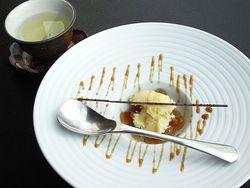
A staff brought to me a pot with a small candle and a plate of green leaves on top as well as a wooden stick. This is for whay?
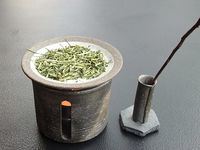
It is the first surprise...I was asked to have these tea leaves grilled by myself while enjoying cups of Gyokuro green tea. This is the first time for me (and maybe many of Japanese clients come here) to roast tea leaves. It is actually required carefull attention to mix these leaves time by time so they are evenly burned. Sometimes a few leaves were out from the plate and another leaves were burned too much...
During Concept G program, tea is prepared with this traditional-style tea making tools by staff.
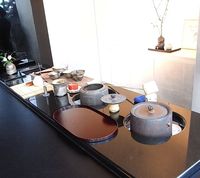
The first cup of Gyokuro green tea is served with a small cup like Sake. Surprisingly the taste of the highest quality tea is totally different from what we have usually as green tea. It is rich and includes “umami” (うまみ). The shiny black cup for the best green tea served on a silver plate. This is like art...

The second cup of Gyokuro tea, following the surprise, is not same with the first cup, even though they are from same tea pot and leaves.
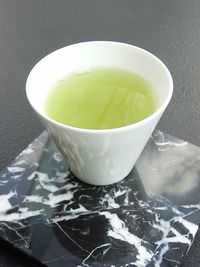
The main dessert plate includes three fantastic sweets. The cake is Gateau Opera “Sakura flavor”.
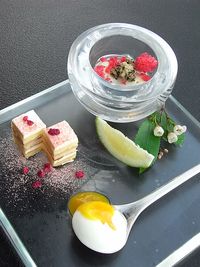
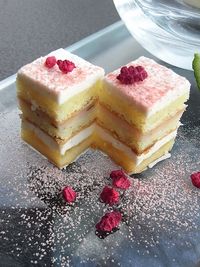
Another surprise was a small plate sesrved...
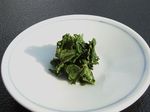
It is tea leaves for the seasonal tea. Normally we just throw away tea leaves after tea is made, while as for the special seasonal sakura tea, it is edible and good with a drop of soy sauce (shoyu)! It was enough good and like boild leafy vegetable.
Finally this is the tea which “I grilled by myself”. Of course it is absolutely tasty too.
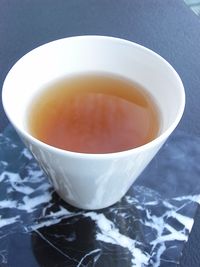
I really enjoyed for apploximately an hour of Concept G world and surely I did discover great combination of Japanese tea and very nice sweets. This is what we cannot have in Tokyo but the concept really well matchs with Kanazawa city’s atmosphere. So it is better to travel to Kanazawa even from Tokyo.
Concept G program is takens place every hour from 11h00 to 17h00 at Le Musee de H in Kanazawa. Advance reservation is recommendable to secure a time slot.
After the tea ceremony, let’s try to find some cakes and cookies for souvenir.
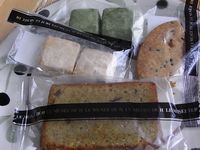
Some products are made with local ingredients. Cake in Kaga Bo-cha (Kaga stick grilled tea), Neige Shoyu (square snow-cookies, soya sauce flavor), Neige Nakajimana (square snow-cookies, local leaf vegetable flavor), Goroshima Kintoki (local sweet potatos) cooky
Concept G, modern tea ceremony program will be followed by a newer post about another unit of Le Musee de H in Wakura Onsen town.
Le Musee de H, Kanazawa (in the building of Ishikawa Prefecture Museum of Art)
*No museum entrance fee required to visit onlyt the sweets shop.
Address: 2-1, Dewa-machi, Kanazawa-city, Ishikawa Prefecture
Website: http://www.kagaya.co.jp/le_musee_de_h/contents/kanazawaConcept.html
*The place is in Kanazawa, Hokuriku region. (not in Tokyo) For general information about Kanazawa and how to get there, please visit below link.
http://aboutfoodinjapan.weblogs.jp/blog/2011/04/about-kanazawa-city-where-food-lovers-should-not-miss-on-travel-in-japan.html
大きな地図で見る
Accommodations close to the sites mentioned on this post
|
It must be fun if we could make Japanese traditional sweets by our own hands. Even in Japan, it is rarely possible but at Kanko Bussankan (観光物産館) in Kanazawa, the hope comes true!!
On weekend in the morning to early afternoon, Japanese sweets making experience program is taken place by a professional sweets-making master in Kanazawa. The lecture is provided in Japanese but I guess even for non-Japanese speakers that could go fair, because the way of making is largely showed in visual step by step by the master in person and through the screens placed around the hall. As long as you pay enough carefully attention on how the master use his hands and tools at each step, mostly you will find how to do there.
All necessary tools and ingredients were ready in front of us when we were seated.
What is important before seated, please wash your hands off well! because your hands are the most useful tool to make the Japanese sweets.
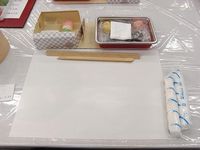
Today’s teacher to give us the class is the sweets making master comes from Takagiya (高木屋), founded in early 20 century.
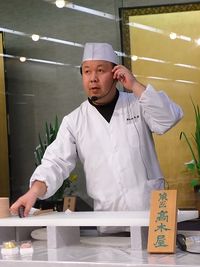
We were going to make three kinds of cake made with beans paste.
White and green dough of beans paste are rounded in a ball.
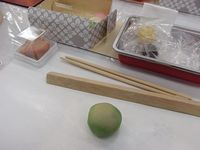
It is almost like a play with clay when we had in childhood. But it is important for sweets making to make the shape quickly as much as possible in order to keep the ingredient cool.
The ball shape paste was wrapped with a wet cloth.
I squeezed the top of the ball tightly as instructed... then it has been transformed to “a butterbur sprout” (ふきのとう fukinoto, an icon of early Spring season).
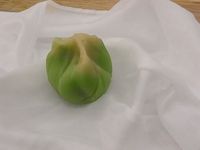
We wondered how we use this net for making sweets with beans paste.
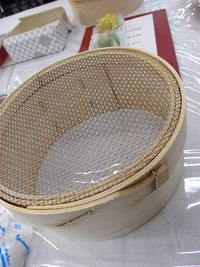
The master showed the way to make the yellow paste into small pieces by getting the dough gone through mesh. Then the small pieces were attached on to a filling dough paste.
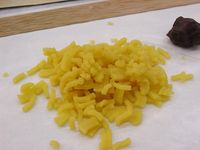
These are my works in colors!
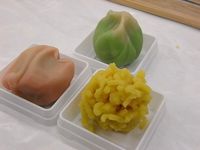
Green – Fukinoto (ふきのとう, butterbur sprout)
Pink – Sakura (桜, cherry blossom petals)
Yellow – Nanohana (菜の花, field mustard)
The program is taken place at Kanko Bussankan (local specialies souvenir shop) just beside of Kenrokuen garden from morning to early afternoon, on 30minutes to 1hour interval during weekend (Saturday, Sunday and bank holidays). It is reservable at the hall reception on site or by phone in Japanese.
Sweets to be made at the class is changed day by day depending on masters and company who provide lesson. The three pieces of sweets made by yourself as well as a piece made by professional can be taken away for your tasting after the experience program.
Related links: Takagiya (高木屋) who provided the lesson on the day
http://www.takagiya.jp
Venue: Kanko Bussankan (観光物産館)
Information about the sweets making experience (in Japanese) :
http://kanazawa.ftw.jp/gaiyo.html
Nearest bus stop: Kenrokuen Shita (兼六園下)
Address: 2-20, Kenrokuen-machi, Kanazawa-city, Ishikawa Prefecture
*The place is in Kanazawa, Hokuriku region. (not in Tokyo) For general information about Kanazawa and how to get there, please visit below link.
http://aboutfoodinjapan.weblogs.jp/blog/2011/04/about-kanazawa-city-where-food-lovers-should-not-miss-on-travel-in-japan.html
大きな地図で見る
Accommodations close to the sites mentioned on this post
|
Japanese traditional sweets (和菓子, Wagashi) is also one of the biggest features of Kanazawa. The sweets making in Kanazawa had been developped with tea ceremony school in Edo period under the governance by Maeda Family which had deep knowledge and patronage to the Tea ceremony culture.
Some traditional sweets producers in Kanazawa continuously run their business over hundreds years since the period. We are able to find their great works at sweets boutiques in the city. To know more about the history and culture of sweets making in Kanazawa, Kashi Bunka Kaikan (菓子文化会館, Confectionery Museum) is open to tourists. It is located between two major tourist spots, Omicho Ichiba and Higashi Chaya. So it will be a good stroll to visit these three spots in a day by taking bus or walk when the weather is fine.
The Confectionery Museum shows old financial records in town to tell how sweets producers were appreciated in Edo period. Sweets making tools in these days were also found. It also introduces different types of Japanese traditional sweets which are served at sesonal events or at rites of life passage.
Some items can be touched directly. They are wooden molds used to make Rakugan (落雁, sugar candy beautifully embossed). I guess they are NOT former tools but still in use at some traditional houses.
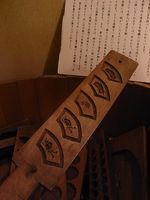
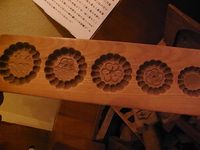
Goshiki Nama Kashi (五色生菓子, Five colors of unbaked cakes)
Traditional cakes to be made for wedding celebletion. The five colors represent “bounty in the universe” (天地の恵み, tenchi no megumi);
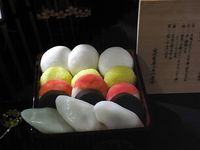 日 (Sun) –red and white cake, reflecting sun rising scene
日 (Sun) –red and white cake, reflecting sun rising scene
月 (Moon) – round shape white cake
海 (Ocean) – ellipse shape of waves in white
山 (mountains) – round cake, yellow rice grains dusted
村里 (people’s village) – black round shape made of steamed Yokan (beans paste cake)
At the last part of the exibihtion, amaging works by modern masters are displayed. Can you imagine the flower decorations are made with “sugar”!
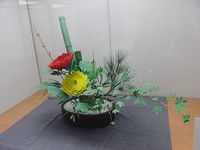
I will also introduce another interesting spot for sweets lovers in following posts.
Related link – Kanazaa Tourist Information Guide
http://www.kanazawa-tourism.com/eng/guide/guide1_3.php?no=6
Kashi Bunka Kaikan (菓子文化会館, Confectionery Museum)
Address: 2-12-1 Owara-cho, Kanazawa-city, Ishikawa Prefecture
*The place is in Kanazawa, Hokuriku region. (not in Tokyo) For general information about Kanazawa and how to get there, please visit below link.
http://aboutfoodinjapan.weblogs.jp/blog/2011/04/about-kanazawa-city-where-food-lovers-should-not-miss-on-travel-in-japan.html
大きな地図で見る
Accommodations close to the sites mentioned on this post
|
It is another kind of joyful moments to be cheered up with local peole and by a nice cup of Sake in a casual restaurant, while having a good time entertained by Geisha at a luxury Ryotei. Kuroyuri (黒百合) is a recommendable place to enjoy local dishes with local alcohol in very casual atmosphere, surrounded by local people. In addition, it is located in a shopping complex adjucent to JR Kanazawa station hence it is easily accessible even by tourists.
Kuroyuri (黒百合) runs the informal dining for over 50 years in Kanazawa. Inside of the restaurant, the main hall is spacious and panoptic. A long U-shape counter in center is able to accommodate around 40 people. Inside the U-shape counter, several cooking staff work busily cutting ingredients, cooking Yakitori (grilled chicken) or taking out drinks or ingredients from a fridge. You may not be bothered while seeing the staff going around and serving clients from the counter with vigorous voice.
The restaurant's important specialty is Oden (おでん), the most popular Japanese homey food. No exact translation in English for Oden. If you know some French food, it can be expressed as “Japanese pot-au-feu”. Various ingredients, such as vegetables, dumplings, egg, shells are cooked for long hours in clear soup. Each restaurant or home has own receip of Oden with each different versions of ingredients to put in a pot. Any kind of ingredients are well soaked with the seasoned soup until begoming soft. At Kuroyuri, it keeps the Oden soup for over 50 years to take over the traditional taste continuously.
For Oden, at Kuroyuri, like some other casual restaurants, guests can select what they would like to have and are charged by piece ordered, within the price range from Yen 100 to around Yen 400 depending on ingredient.
What I ordered are...
Daikon (Japanese raddish) typical Oden-vege,
Kurumafu (車麩, round shape “fu” wheat gluten, one of local specialties in Kanazawa),
Baigai (梅貝, also local specialty sea shell),
Iwashi Tsumire (鰯のつみれ, dumpling of minched sardine).
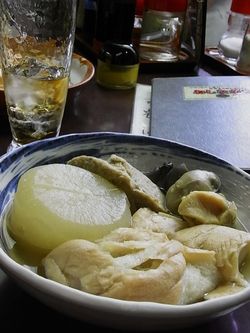
Of course, it offers wide selections of local Sake, Umesh (plum liqueur) as well as beer and Shochu from Kyushu region.
Restaurant name: Kuroyuri (黒百合)
Location: Ajiwai-kan (あじわい館), Kanazawa Hyakubangai (百番街)
*It is located on the restaurant floor at ground level of the biggest shopping complex (Hyakubangai 百番街), adjucent to JR Kanazawa station. Just a few minutes walk from Station gate.
Website: http://kuroyuri.ftw.jp
*The place is in Kanazawa, Hokuriku region. (not in Tokyo) For general information about Kanazawa and how to get there, please visit below link.
http://aboutfoodinjapan.weblogs.jp/blog/2011/04/about-kanazawa-city-where-food-lovers-should-not-miss-on-travel-in-japan.html
大きな地図で見る
Accommodations close to the sites mentioned on this post
|
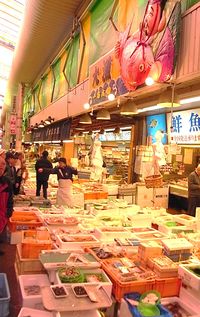 During my stay in Kanazawa, I often dropped by Omicho Ichiba (近江町市場) food market in central Kanazawa. The market’s history dates back to 280 years ago and it has attracted local residents of Kanazawa and tourists since that time. At Omicho Ichiba, which is called “Kanazawa citizens’ kitchen pantry” (金沢市民の台所) in anoother words, around 170 small business organizations are based and they provide a plenty number of food products, from local specialty seafood, local species Kaga vegetables, meat, fruits to green tea, spices and traditional sweets etc. Even though we have no way to cook the raw seafood products during a trip, it is a good opportunity to explorer fresh local foods in the region. In the morning, restaurant operators and professional buyers are main clients of Omicho Ichiba, while local ordinary people fill the market in late afternoon to get ingredients for their dinner at home.
During my stay in Kanazawa, I often dropped by Omicho Ichiba (近江町市場) food market in central Kanazawa. The market’s history dates back to 280 years ago and it has attracted local residents of Kanazawa and tourists since that time. At Omicho Ichiba, which is called “Kanazawa citizens’ kitchen pantry” (金沢市民の台所) in anoother words, around 170 small business organizations are based and they provide a plenty number of food products, from local specialty seafood, local species Kaga vegetables, meat, fruits to green tea, spices and traditional sweets etc. Even though we have no way to cook the raw seafood products during a trip, it is a good opportunity to explorer fresh local foods in the region. In the morning, restaurant operators and professional buyers are main clients of Omicho Ichiba, while local ordinary people fill the market in late afternoon to get ingredients for their dinner at home.
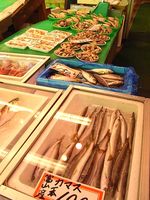 Some seafood shops are able to arrange refrigerated courier service for tourists so they can taste the region’s fresh seafood such as crab, shells, shrimps and fish at home on their return. Of course these shop staff are friendly and happy to tell us the best way to cook them.
Some seafood shops are able to arrange refrigerated courier service for tourists so they can taste the region’s fresh seafood such as crab, shells, shrimps and fish at home on their return. Of course these shop staff are friendly and happy to tell us the best way to cook them.
The most expensive crab in the picture costs at Yen 15000 (applox USD 188 or EUR 125 per crab). The price varies day by day and depends on condisions. A plate says “Jimono” (地物, local products) landing within Ishikawa prefecture (whose capital is Kanazawa).
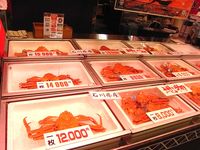
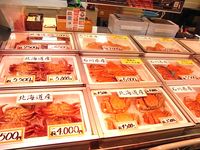
The market administration was calling for people to contribute to paper cranes making to pray for the earthquake and tsunami victims in Tohoku, when I visited there around three weeks after the natural tragedy.
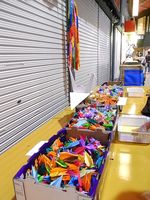
Well... after looking around such atrractive fresh seafoods, why not try them at a restaurant in Omicho Ichiba? Yes! The market offers the option at some restaurants there. On the ground floor, some small, mainly seafood or sushi, restaurants can be found and on the basement and second floors, more number of restaurants serve various cuisine with fresh ingredients from the market.
I selected one of the restaurants on the ground floor in Omicho Ichiba, which is called “Omicho Shokudo” (近江町食堂, Omicho’s dining) and known as a place where the market workers come to have their own meals. It is located at a hiding place, as local people called it “ana” (穴, a hole) then I could find it soon at first...
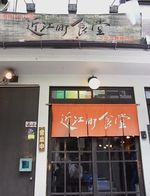
The restaurant exists a few steps back off from the edge of market street.
It offers different variations of Kaisendon (海鮮丼, seafood bowl) as well as lunch set with sashimi etc.
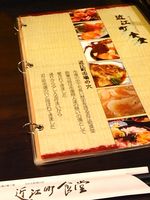
The most typical one is “Ganso Kaisendon” (元祖海鮮丼, the original seafood bowl) for which 8 kinds of sashimi (刺身, raw fish/seafood) are placed on top of rice bowl. Fish/seafood served are changed season by season, my bowl includes symbolic local specialties, uni (ウニ, 雲丹, sea urchin), ikura (イクラ, salmon caviar), ama-ebi (甘エビ,” sweety” deep-water shrimp), kani (カニ, 蟹, crab meat). What a dreaming time it is....
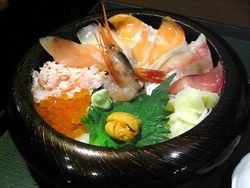
As a side dish, tempura of “Goro Kintoki” (五郎金時) sweet potato was also nice.

Please do not miss strolling in “the universe of Kanazawa local foods”!
Omicho Ichiba official website (Japanese version only) http://www.ohmicho-ichiba.com
Restaurant name: Omicho Shokudo (近江町食堂)
Website (Japanese version only): http://www.ohmicho.jp
*The place is in Kanazawa, Hokuriku region. (not in Tokyo) For general information about Kanazawa and how to get there, please visit below link.
http://aboutfoodinjapan.weblogs.jp/blog/2011/04/about-kanazawa-city-where-food-lovers-should-not-miss-on-travel-in-japan.html
大きな地図で見る
Accommodations close to the sites mentioned on this post
|
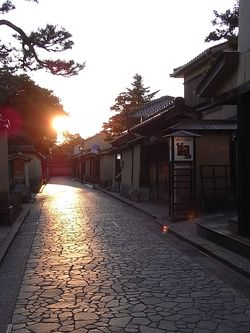 Nagamachi (長町) district, known as a lovely old town and former Samurai residents remain, is situated behind the city’s most vital shopping and dining district Korinbo (香林坊). It exists like a hidden small jewery. You will find it by walking down for five minutes from Kanazawa Excel Tokyu Hotel, leaving off Korinbo on the main street of Kanazawa. Enjoy “a time trip” from 21st century to Edo era!
Nagamachi (長町) district, known as a lovely old town and former Samurai residents remain, is situated behind the city’s most vital shopping and dining district Korinbo (香林坊). It exists like a hidden small jewery. You will find it by walking down for five minutes from Kanazawa Excel Tokyu Hotel, leaving off Korinbo on the main street of Kanazawa. Enjoy “a time trip” from 21st century to Edo era!
In the district of Naga-machi Buke Yashiki (長町武家屋敷跡, Nagamachi former Samurai houses), some traditional buildings are open to public as museums, tourist attractions, Kutani porcelain (九谷焼) shops or sweets boutiques. Please enjoy walking around and dropping by old houses to dicover Japanese great works in traditional art, handicrafts and foods available in the area.
The walls were made with mud exterior, stones inside and wood plates as its roof on top.
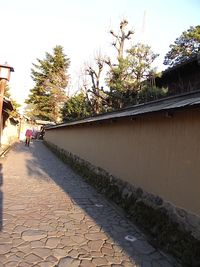
Must-see spot in Nagamachi is Nomura Samurai Family Residence (武家屋敷跡野村家) that was awarded two starts ** by Michelin Guid in 2009. The residence is filled with fantastic art, craft and decorations placed or put as a part of the house’ funiture fittings. The garden is also beautifully kept in green and it looks like a profound unique world with creek and pond where some white-and-red colors carps swim elegantly. I do not know exactly how I can describe the place’s aesthetic…
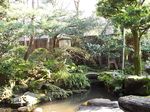
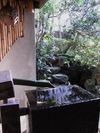
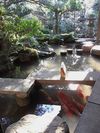
Nomura Samurai Family Residence (武家屋敷跡野村家)
Website (though it is under contraction so far): http://www.nomurake.com/
After impressed by the samurai resident, it is time to satisfy your appetite maybe. Several sweets boutiques can be found too in the area. Some of them offer Japanese green tea and/or sweets at a small café space, in some cases, looking at a Japanese garden. Where I visited is a bit off from the main street but it is worth taking more minutes walk to find the machiya café (町屋カフェ) or café in renovated old town house (古民家カフェ).
Entering through two silding doors and proceeding on ston floor, I found Kinkato (金花糖) a space like cozy and warm home-away-home. In the quiet and heated air, anyone will be relived, having homeade sweets made with Japanese traditional ingredients.
On March, when I visited, Hina ningyo (雛人形, girls festival dolls) are displayed.
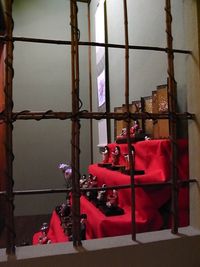
I spotted cute brush drawing on wall just above a cushion.
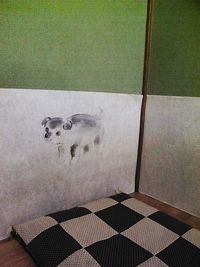
Crean anmitsu (クリームあんみつ, Japanese parfait with beans paste and vanilla ice cream) is one of Kinkato's most popular item here.
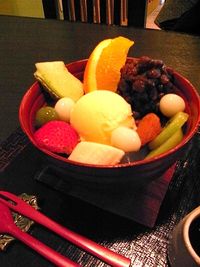
Zenzai (sweet beans soup), Rice cake or homemade ice cream are available by season.
Café name: Kinkato (金花糖)
Opening hour: noon to Yugre-doki “dusk” (夕暮れ時, around sunset time) – what a chic expression of time by the owner!
Address: 3-8-12 Nagamachi, Kanazawa-city, Ishikawa prefecture (check below map)
Website (Japanese only): http://fubako.s150.xrea.com/
*The place is in Kanazawa, Hokuriku region. (not in Tokyo) For general information about Kanazawa and how to get there, please visit below link.
http://aboutfoodinjapan.weblogs.jp/blog/2011/04/about-kanazawa-city-where-food-lovers-should-not-miss-on-travel-in-japan.html
大きな地図で見る
Accommodations close to the sites mentioned on this post
|
A major Japanese supermarket chain, Ito-Yokado conducts special promotion called "Gambaro Tohoku" (がんばろう東北, difficult to translate exactly,,,, in my way, Fight Tohoku!) until this Saturday 10th April 2011. At Ito-Yokado 140 units, to support food producers in Tohoku, special fair is taken place to introduce about 60 products in Tohoku, in some cases at special promotion price.
Food products to be offered at the promotion are different store by store and day by day. For example, their units in Tokyo and surrounding area, consumers will/do/did find apples and scallops from Aomori (青森), beef from three prefectures got the most serious damage, Iwate (岩手), Miyagi (宮城) and Fukushima (福島), yoghurt drink from Iwate, rice from Fukushima. In addition, at some units yesterday, Ito-Yokado offered at special price lettuce made in Ibaraki, where farmers saw serious sales drop after the nuclear power plant problem.
The major supermarket chain headquater examined and reconfirmed with a private sectore research center that these products are proved safe from radioactive health problem.
Other supermarket chains are intending to follow the promotionn by Ito-Yokado. Such as Aeon, Tokyu store are planning to start offering argricultural products from Tohoku at some of their units.
As the main event of my journey in Kanazawa, I visited Tsubajin (つば甚) for lunch. With its history of over 250 years long since 1752, Tsubajin is one of the most established Ryotei (料亭) in Kanazawa. Out of Nishi Chaya Machi (にし茶屋街), the traditional Japanese house build in early 20 century stands on a bank of Sai river (犀川). From the upper floor, Kanazawa city view is available.
Approaching to the restaurant entrance, a lady in Kimono opened the entrance door and welcomed me with smile. I already recognized that this kind of hospitality prooves the restauran as a place where royal family, politicians and other celeblities have been welcomed for long years. We were taken to a room on the ground floor, where we can find a small but nice Japanese garden outside while inside seasonal decoration of Hina ningyo (雛人形, Girls festival dolls), kakejiku (掛け軸, traditional painting scroll) and a flower base. They are modest but creats elegant tast collectively.
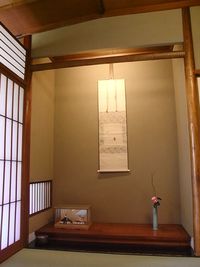
The staind glass partion on the left stand implies Taisho period (大正時代) when this house was built.
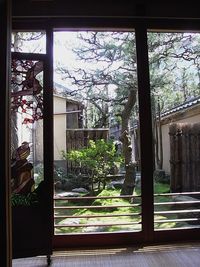
It is a place where we can be fully relaxed even before lunch...
Sake (日本酒) sevred is original brand of Tsubajin (つば甚), blended specially for the restaurant. Dry but fruity, modest and good quality exactly like the restaurant!
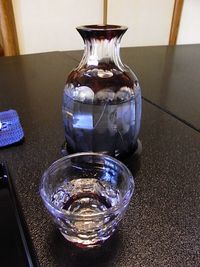
The least expensive lunch is box meal style, because I have to keep my stomach space for dinner and sweets on afternoon. If you would, Kaiseki style meal is also available depending on your budget.
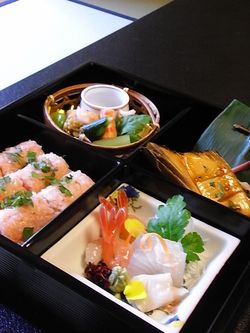
Grilled Takenoko (筍, bamboo shoot) is icon of Spring. Behindit, masu (鱒, trout) also grilled and wrapped by a dark green leaf and decorated with a small piece of cherry flower.
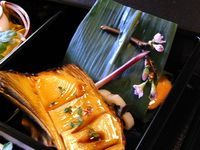
Sasimi (刺身, raw fish) plate is essential for Japanese course meal.Here it includes very fresh seasonal local product.
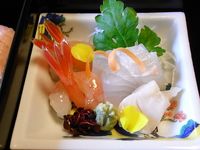
Jibuni (じぶ煮), well-known local speciality (郷土料理, Kyodo Ryori) of Kanazawa, ordered with supplement cost. Duck meat, local speciality product “fu”(麩, wheat gluten cake) and vegetables including local spiecies of spinach Kinjiso (金時草).
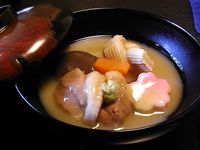
The excellent lunch was ended with a small bowl of dessert
I left the restaurant with great satisfaction. It was a perfect moment of fine traditional and fresh cuisine, interior decoration and Japanese hospitality.
About Ryotei (料亭)
No clear difinition of Ryotei but it is considered as the most luxurious category of traditional Japanese restaurants with established business in long history, appreciated by local magnates and VIPs, capacity and ability to arrange entertainment by Geisha. Many are located in Kyoto, Tokyo and Kanazawa. Because of nature of their clientels, dinig space is most likely to be “private room” style where you would never find and hear other diners. To have meals in Ryotei, advance reservation is required and in most case chef’s recommendation course is provided according to your budget given upon reservation. (It means they rarely allow you to visit without reservation and to select plates from a list on the spot.) Please be ready enough earlier to take advantage of fantastic experiences feeling Japanese traditional culture!
Tsubajin (つば甚)
Address: 5-1-8 Teramachi, Kanazawa-city, Ishikawa prefecture
Website: http://www.tsubajin.co.jp
*The place is in Kanazawa, Hokuriku region. (not in Tokyo) For general information about Kanazawa and how to get there, please visit below link.
http://aboutfoodinjapan.weblogs.jp/blog/2011/04/about-kanazawa-city-where-food-lovers-should-not-miss-on-travel-in-japan.html
大きな地図で見る
Accommodations close to the sites mentioned on this post
|
While launching current "my journey serise Kanazawa" this week, I cannot miss an opportunity to introduce this event in Tokyo.
A month long campaign has been started by Marche (named after "market" in French) Kotsukaikan (交通会館) organizer, in order to support farmers based in Fukushima and Ibaraki prefecutures, where they have gotten the most serious damage in sales shrink cased by the nuclear power plant problems.
The market organizer aims at enlighten consumers with correct information of food safety level directly from farm producers in Fukushima and Ibaraki. The market is held from 1st April through to 8th May 2011 at Marche Kotsuskaikan (交通会館). (It is just in front of JR Yurakucho station and the market is on the ground floor outside terrace.) Farmers and members of local agriculture associations from Fukushima and Ibaraki appear with their products such as rice (harvested in last fall obviously), beef and vegetables. They offer tasting, sell their producted proved safe and occasionally show numerical value of radiation level on a "Geiger counter" in front of visitors.
The promotional event has been featured by Japanese media widely. As per the market organizer official site, the market is successfull everyday with many supporter-consumers coming to support these farmers and purchasing their arricultural products.
Of course I will visit there to get some products within a month, especially because my rice stock is soon run out...
Related news: Fukushima farmers seek to prove their food is safe | The Japan Times Online.
Marche at Kotsukaikan (交通会館マルシェ), Yurakucho, Tokyo
Opening hours:
Monday to Friday - 12h00 - 18h00 (around 5 sellers appear)
Saturday, Sunday and Holidays - 11h00 - 17h00 (operated much bigger scale, 20-25 sellers)
Address: 2-10-1 Yurakucho, Chiyoda-ku, Tokyo
*In front of JR Yurakucho station, from Kyobashi Exit (Ginza side), between JR station and ITOCIA shopping complex.
大きな地図で見る
Higashi Chaya district (ひがし茶屋街) is one of the must-see points for tourists visit Kanazawa. The two-story houses in traditional style, made with wooden flames, some of them painted in dark red, stretch in a row along the main street made of stone blocks and over a hundred meters long. If you are enough luck to be there in quiet time without tourists in modern looks, you must feel as if you were traveling to the past, in Edo period.
Some of buildings in Higashi Chaya district are still used for the original purpose, which was set up in 1820, Chaya (茶屋) where feasts and entertainment are taken place with Geisha (芸者) on the upper floors of the buildings on evening. Others are restored and transformed to restaurants, café or souvenir shops and so on. So you may have a chance to go inside of these buildings in Higashi Chaya district. During day time, the small historic town is normally filled with tourists. But when I visited, it was rather calm and less crowded, even on school holiday season, after less than three weeks from the natural disaster in Tohoku region.
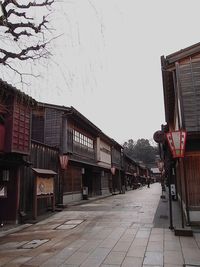
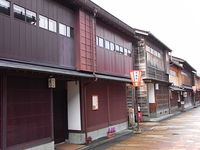
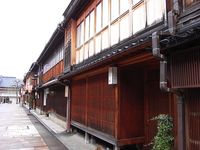
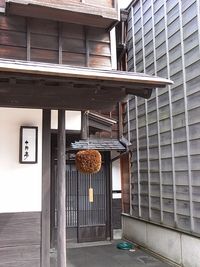
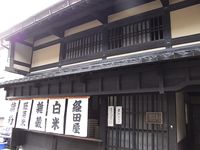
Right: Rice store in very traditional style It is just off from the main street.
It is just off from the main street.
I visited Kaikaro (懐華樓) to look how Chaya is like inside and to enjoy tea time in the traditional building. It is the biggest Chaya in Kanazawa and is situated around the middle of the main street. On evening, Kaikaro accepts “referral clients only” for feast and entertainment by Geisha, as others in same business do. As its policy, Kaikaro welcomes only one client group for evening per day. During daytime, the house is open to tourists for viewing inside with entrance fee. It is a good opportunity to know how the Geisha world is…
Imagine? Climing up the steps what we will see….
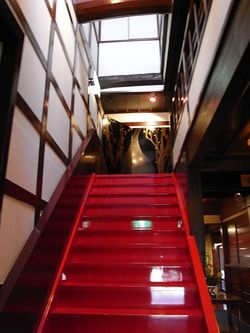
On the upper floor, it has two dining halls, dressing room for Geisha, reheasal room etc. It is interesting to imagine how they are used on evening…
After visiting the upper floor, we can take a break at the café on the ground floor. Please do not miss it as the space is also worth visiting and spending some time with Japanese tea.
Maybe this is the first time even for me to find “active” Irori (囲炉裏, Japanese style fireplace).
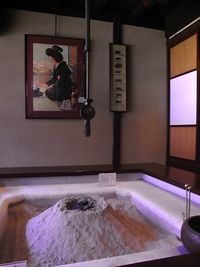
The widow side is decorated with folk arts, antiques, fans with name of Geisha hang on the upper side of wall.
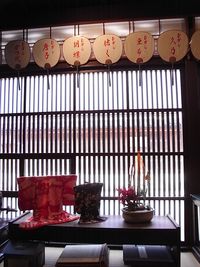
I had Japanese traditional sweets, Kudzu (葛, made from a kind of beans) jelly in noodle shape and sweet black syrup to dip Kudzu. Kinpaku (金箔, gold leaf) float in the syrup !! (No worry it is safe to eat.)
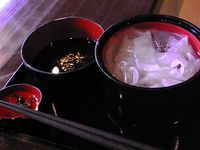
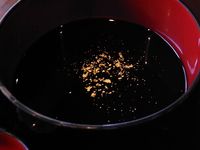
Kaikaro offers combination plans of Chaya entrance fee with Japanese sweets or Maccha (Japanese tea) or softdrinks.
Kaikaro (懐華樓)
Address: 1-14-8 Higashiyama, Kanazawa-city, Ishikawa prefecture
Website: http://www.kaikaro.jp
*The place is in Kanazawa, Hokuriku region. (not in Tokyo) For general information about Kanazawa and how to get there, please visit below link.
http://aboutfoodinjapan.weblogs.jp/blog/2011/04/about-kanazawa-city-where-food-lovers-should-not-miss-on-travel-in-japan.html
大きな地図で見る
Accommodations close to the sites mentioned on this post
|

